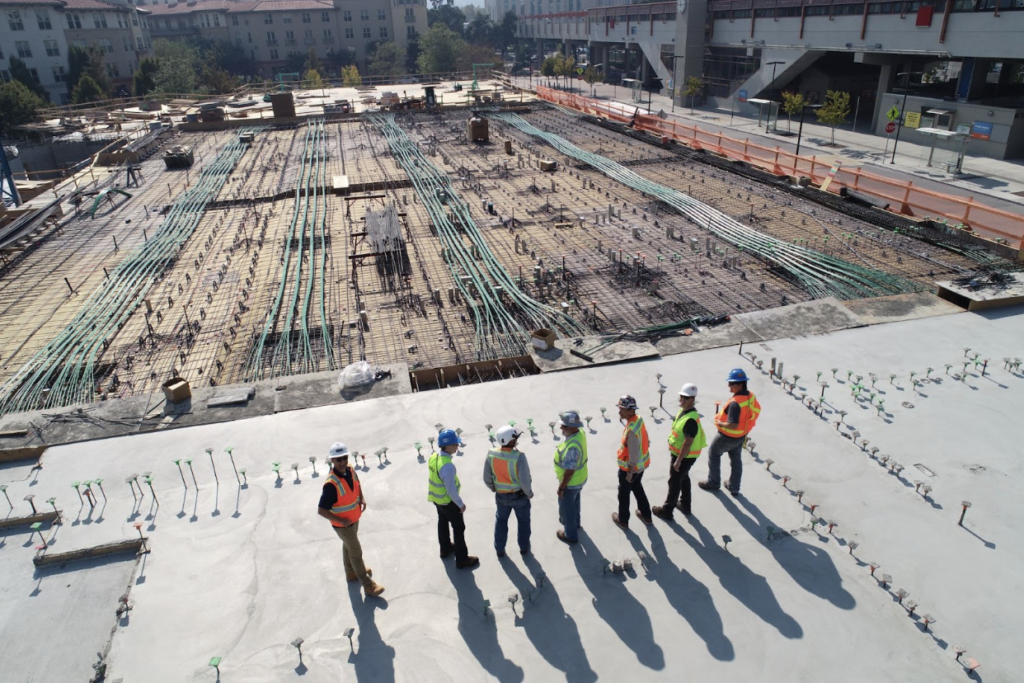The 4 Main Construction Industry Archetypes
This is a long one because it’s a topic Tim and I both are super passionate about.
How to increase sales, be more efficient, get more business by deeply understanding and relating to your clients.
This a deep dive follow-up to the VE Conundrum episode we dive deeper into the players at the VE table.
How do you figure out who you’re talking to? We get into the nitty-gritty and break it all down for you. This episode will make you lots of money and greatly diminish heartache and stress if you implement this into your everyday life.
Full Interview Transcript
4 Main Construction Industry Archetypes

Alt Text: A group of seven construction workers stand on the roof of a construction sight and talk.
This week, Tim and Carolina discuss the four main types of people who work in the building construction industry and why it is imperative to understand their needs and motivations when selling to them.
More About the Show
The Build Perspectives podcast shares insider knowledge to build connections and community in the building materials industry. Tim and Carolina are friends, colleagues and former coworkers who love the construction industry and their clients, and they want to share their passion and insights to attract future talent to the industry.
In this episode, Tim and Carolina use the Ideal Customer Avatar as an exercise to better understand the different personas that people are likely to encounter in the building construction industry. They talk about the importance of empathy and marketing basics when approaching potential clients.
About the Ideal Customer Avatar (ICA)
Tim explains that one of the best ways a sales representative can stand out and earn more sales is through value engineering, and the number one way to achieve this is by having empathy for the customer.
He believes it’s imperative to look at how we work with the people in the business and emphasizes the importance of viewing the building construction industry as people, not companies.
Carolina explains that while it’s important to target ideal companies you’d like to work with, it’s more important to know the specific person and their role when approaching them. She talks about the Ideal Customer Avatar exercise that she learned about in Marie Forleo’s B-School and the importance of understanding your ideal customer’s specific concerns, problems and everyday issues.
When creating an ICA, Carolina says to think about traits that all of your ideal customers have in common — compile those traits into a list and then create a profile. This should include demographics such as age, gender, level of education, annual income and where they are located. You can get this information by looking at who you’ve interacted with in the past. Tim explains that this is not a political statement but rather a real-world denominator that they all share in common.
Once you have the ICA created, Carolina says to write your marketing copy and sales pitch as if you are speaking directly to your ideal customer. While you don’t write out every customer who doesn't fit your specific ICA, Carolina suggests spending marketing dollars trying to attract that one person that is your ideal client. This ensures that you spend the right time with the right people for the right projects. This also helps to increase job satisfaction because you will actually enjoy working with these people.
Tim and Carolina discuss the four main roles that you should create an ICA for — architect, designer, general contractor and subcontractor.
Architects

Alt Text: A person sits at a desk is sketching a building on a piece of white paper while looking at blueprints on a computer.
When creating an ICA for an architect, it’s important to hone in on who you want to work with. Tim discusses the benefits that result from working with your ideal client, like higher efficiency, being more well-liked and a higher likelihood of getting repeat business.
Architects want to drive by a project and feel good about it. They want to be able to show off their work and not have to worry about low-quality materials.
There are multiple personas that can fit in each archetype, so it is beneficial to understand the specific architect you are trying to attract. Tim discusses the needs of principal architects and how they differ from the needs of designers.
Developers/Owners
According to Tim and Carolina, developers and owners are the ones with the most at stake in construction projects. This is because they have investors to answer to and are responsible for making sure that the project stays on budget and on time. A shrinking 20% of commercial projects are on-time and in-budget, whereas over 80% are over-time and over budget.
When a project goes over time or budget, Tim explains that developers have to make a capital call to investors explaining why the project’s progress is not where it needs to be. This is always inefficient and annoying for investors and developers, so do what you can to make the process more efficient and reliable for them.
As a manufacturer’s representative, Carolina explains that developers can be your best clients. If you play your cards right and serve them well, it is easy to get return business and a good stake in the ground.
However, she also mentions they’re used to getting their way — they can be abrasive and demanding. It’s important to have a marketing plan established so that you don’t get muscled around. Tim suggests tactical preparation. While developers can push back, they are also looking for someone to push back on their demands — it can be a test of sorts.
Generally speaking, this is not a time to freak out. State your case and know exactly why you want to work with them. The only time this doesn’t work is when you don’t know what your case is. If they don’t agree with you, move on because they aren’t your ideal customer. Don’t waste your time — there are other developers who will want to work with you.
General Contractors
Tim shares that general contractors value time and cost efficiency the most. He says it’s important to keep in mind that your customer avatars have their own customer avatars — remind general contractors of their customers’ wants, needs, motivations, desires and fears.
Even though general contractors don’t have as much at stake as the developers, they have one of the harder jobs with managing labor, materials and the client. They want to add value to projects because their goal is to get repeat business. Sometimes, their solution is value engineering.
When the general contractor thinks about adding value for future business, Tim said they often think, “How do I raise the blister for a problem that may or may not exist so that I can create value without compromising the quality of the project?”
Another way for them to add value is through mastery of labor. There are also people who are mastery of materials — however, the mastery of materials folks look to target mastery of labor folks because they have materials that will help the laborers with their projects.
Carolina explained that there are levels of personas within the general contractor and within the category of the archetype. This is because, again, they are people, not companies.
Installers/Subcontractors
Tim shared that subcontractors are typically 70% mastery of labor people and 30% mastery of material people. The key to commercial project installers is understanding the channel by which they get materials: direct or one-step processes.
Commercial versus residential applications plays a big role when targeting installers and subcontractors. Depending on what type of product you sell, this information is critical.
Although homeowners are becoming more and more educated, the installer has a lot of power over selecting products in residential construction. The speccing for residential versus commercial applications is very different. In addition, the installer has a lot of say over materials that are commoditized and well-stocked, but they have less control over specialized items.
Things to keep in mind about installers:
- What world do they operate in?
- Who are the applicators in that world?
- What are their motivations?
Carolina encouraged listeners to highlight the installer’s projects. Take a photo of it and send it to them with a message about how much you like it. Doing this will not only make their day, but it will give them a reason to remember you and gives them material to share with other people — this will simultaneously increase your chances of earning their business repeatedly.
Show Dignity and Empathy
Tim emphasized the importance of getting out of your own world and focusing on the people whom you serve and their motivations. Doing so makes it easier to create personal connections and build trust.
Carolina pointed out that once you’ve created your avatar, you can figure out their interests and find more customers like them. It also allows you to create a more personal connection without constantly pitching yourself to them.
Tim mentions tools for marketing managers:
- SparkToro: Ran Fishkins’ tool that uses multiple APIs to pull in what people are thinking and talking about.
- Lookalike Audiences: Gives you an ideal overall view of the social network market you are focusing on. It provides insight into what they like and what they dislike.
Carolina encourages learning more about the persona and sharpening it through idea extraction. Gather a list of 5-10 questions to ask your top clients and ask them about pain points that they need solutions for.
According to Tim, you cannot dignify the person from a place of real empathy unless you understand this exercise of the ideal customer persona.
When they call you and they need help, show them the dignity that another human being who is up against real challenges deserves — they will never forget that.
Show Notes:
- Marie Forleo’s B-School
- SparkToro
- About Lookalike Audiences
- Past Episode Tim Mentions: How to Write Your Own Ticket with Dewayne Thomas
